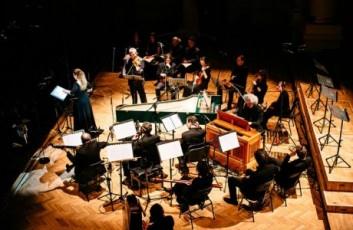Antonio Caldara - Morte e sepoltura di Cristo (2014)
Antonio Caldara - Morte e sepoltura di Cristo (2014)

1. Morte e sepoltura di Cristo I 2. Morte e sepoltura di Cristo II 3. Morte e sepoltura di Cristo III 4. Morte e sepoltura di Cristo IV 5. Morte e sepoltura di Cristo V Maria Grazia Schiavo, soprano - Maria Maddalena Monica Piccinini, soprano - Maria di Giacobbe Martina Belli, contralto - Giuseppe d'Arimatea Carlo Allemano, tenor - Nicodemo Ugo Guagliardo, bass - Centurione Europa Galante Fabio Biondi – conductor Misteria Paschalia Festival 2014 April 15, 2014 Karol Szymanowski Philharmonic Hall, Krakow
With Antonio Caldara’s "Morte e sepoltura di Christo" Fabio Biondi returns to the Italian oratorio, another of his specialities. The Venetians Caldara and Vivaldi may have been contemporaries but their career paths led them in different directions, and Caldara was to spend much time working in Mantua and Rome before securing the position of vice-Kapellmeister for the Holy Roman Emperor Charles VI in Vienna. For the last twenty years of his life Caldara produced copious quantities of oratorios (and operas), adding a rich sense of counterpoint and making use of the broad orchestral colouring offered by the varied instruments available to him at the Imperial court. Composed for the Lenten season in 1724, Morte e sepoltura follows the typical two-part scheme of the time, to a text comprising a series of reflections as from personages involved in some way in the events of the Passion of Christ. Notable is the profusion of solo arias with obliggato instrumental parts. ---glossamusic.com
In the Viennese oratorios the demands of the weightier court style led Caldara to return to four-part strings and a cast of five or six soloists covering the full vocal range. Instrumental scorings become more sonorous; the textures - whether of the almost invariable slow-fast introduzioni or of aria accompaniments - are more contrapuntal. Vocal writing, wide in compass and often incorporating convoluted rhythmic figuration and fioritura as demanding as any found in the opera arias, is exposed in large-scale structures. All this suggests a composer preoccupied with the individual movement rather than the overall dramatic flow. Even so, the dramatic incidents found in several of the librettos (such as the fall of the city walls in La caduta di Gerico, 1719) are vividly set, and brief turba choruses increase the tension of such moments. Caldara's most sustained choral writing, however, occurs in the madrigalesque, moralizing choruses that conclude each of the two parts of every Viennese oratorio. Homophonic and diverse imitative textures are juxtaposed in these multi-sectional choruses, which culminate in extended fugal writing.
Caldara's wide range of obligato instruments lends colour to the court oratorios and further distinguishes them from his pre-1716 repertory. At times the choice is quite literal since the trumpet is mandatory for such texts as "Dolce suono di trombe" in Gioseffo (1726) and "Risvegliate metalli sonori" in La caduta (1719); his more frequent use of the scialmo, trombone, bassoon, violin and cello, either singly or in combination - such as the two trombones and bassoon in "Deh sciogliete" from Morte e sepoltura di Cristo (1724) - is usually inspired by the Affekt of the text. ---grovemusic.github.io
download (mp3 @320 kbs):
yandex 4shared mega mediafire uloz.to cloudmailru uptobox ge.tt








